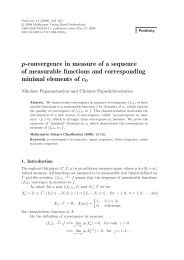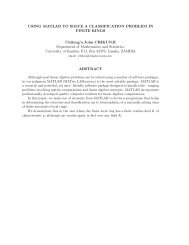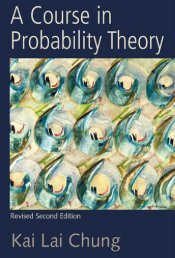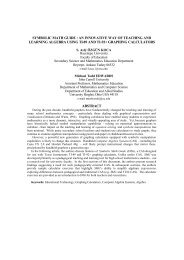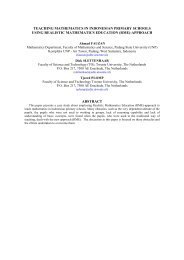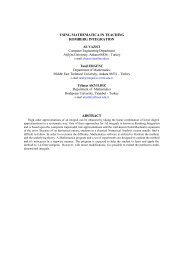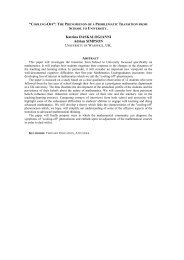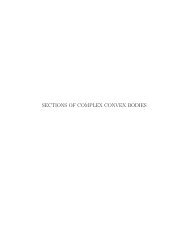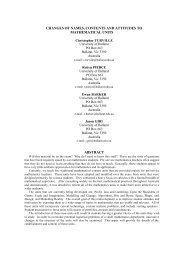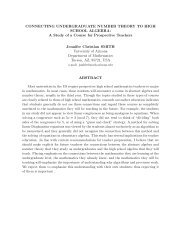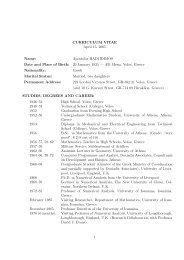Sociocultural factors in undergraduate mathematics
Sociocultural factors in undergraduate mathematics
Sociocultural factors in undergraduate mathematics
You also want an ePaper? Increase the reach of your titles
YUMPU automatically turns print PDFs into web optimized ePapers that Google loves.
SOCIOCULTURAL FACTORS IN UNDERGRADUATE MATHEMATICS:<br />
THE ROLE OF EXPLANATION AND JUSTIFICATION<br />
Desp<strong>in</strong>a A. STYLIANOU<br />
University of Massachusetts, Dartmouth<br />
Mathematics Department<br />
285 Old Westport Road<br />
N. Dartmouth, MA 02747-2300, USA<br />
dstylianou@umassd.edu<br />
Maria L. BLANTON<br />
University of Massachusetts, Dartmouth<br />
Mathematics Department<br />
285 Old Westport Road<br />
N. Dartmouth, MA 02747-2300, USA<br />
mblanton@umassd.edu<br />
ABSTRACT<br />
This paper extends the study of social <strong>in</strong>teraction patterns as a means to characterize <strong>mathematics</strong> learn<strong>in</strong>g to the<br />
learn<strong>in</strong>g and teach<strong>in</strong>g of <strong>mathematics</strong> at the <strong>undergraduate</strong> level. We present here the analysis of teach<strong>in</strong>g<br />
episodes from a discrete <strong>mathematics</strong> course to document the change <strong>in</strong> social and sociomathematical norms<br />
over the course of one semester. First, the <strong>in</strong>structor established the social norm that students justify, expla<strong>in</strong> and<br />
share with their peers their th<strong>in</strong>k<strong>in</strong>g and solution processes. We show how the <strong>in</strong>structor of the course<br />
established an expectation for explanation and justification, and how students’ <strong>in</strong>teractions developed <strong>in</strong><br />
accordance to this normative understand<strong>in</strong>g through the semester. That is, we trace students’ development from<br />
the passive acceptance of the <strong>in</strong>structor’s authority to the expectation that students become contributors to the<br />
class and that they all share common understand<strong>in</strong>gs. We then shift our focus to the sociomathematical norms –<br />
normative <strong>in</strong>teractions specific to <strong>mathematics</strong>. We discuss the development of students´ explanations from the<br />
procedural level to ones that are grounded <strong>in</strong> deeper conceptual understand<strong>in</strong>gs. We f<strong>in</strong>ally l<strong>in</strong>k the shift <strong>in</strong> the<br />
aforementioned social and sociomathematical norms <strong>in</strong> students’ <strong>in</strong>teractions to the development of students’<br />
ability to reason deductively.
Introduction<br />
Schoenfeld argued that “<strong>mathematics</strong> is an act that is socially constructed and socially transmitted”<br />
(1992, p. 335). As such, it is governed by a set of norms; an etiquette for what is deemed appropriate<br />
behavior by members of the <strong>mathematics</strong> community. These can be social rules, that is, the ways <strong>in</strong> which<br />
members of the community <strong>in</strong>teract and exchange ideas – rules that are not specific to <strong>mathematics</strong> but may<br />
characterize the behavior of members of other fields (e.g., historians). There is also a set of mathematical,<br />
or sociomathematical rules, that is, rules that are specific to the field of <strong>mathematics</strong>, such as what<br />
constitutes a proof (Cobb, Wood, Yackel, McNeal, 1992; Yackel & Cobb, 1996). While the second set of<br />
rules are explicit <strong>in</strong> the field, the first set can be very implicit. And yet, one may argue that social norms<br />
constitute the broad basis upon which the mathematical norms are constituted.<br />
In recent years, we have witnessed a renewed <strong>in</strong>terest <strong>in</strong> this social facet of <strong>mathematics</strong> and a grow<strong>in</strong>g<br />
tendency <strong>in</strong> study<strong>in</strong>g social <strong>in</strong>teraction patterns as a means to characterize <strong>mathematics</strong> learn<strong>in</strong>g (e.g.,<br />
Yackel, 2001). Yet, little work has been done at advanced levels; the bulk of the research <strong>in</strong> this area has<br />
been conducted <strong>in</strong> elementary and secondary school classrooms (Cobb & Bauersfeld, 1995; Cobb, Yackel<br />
& Wood, 1992). In this paper we jo<strong>in</strong> the efforts of Yackel, Rasmussen and K<strong>in</strong>g (2000) to extend these<br />
analyses to the learn<strong>in</strong>g and teach<strong>in</strong>g of <strong>mathematics</strong> at the <strong>undergraduate</strong> level us<strong>in</strong>g data from a<br />
classroom teach<strong>in</strong>g experiment <strong>in</strong> discrete <strong>mathematics</strong>. We document the development of social and<br />
sociomathematical norms regard<strong>in</strong>g explanation and justification over the course of one semester, and we<br />
discuss how these norms were constituted <strong>in</strong> this specific case.<br />
First, we focus on the social norm that students publicly expla<strong>in</strong> their th<strong>in</strong>k<strong>in</strong>g and solutions and try to<br />
make sense of other students’ th<strong>in</strong>k<strong>in</strong>g. We show explicitly how the <strong>in</strong>structor of the course established an<br />
expectation for explanation and justification, and how students’ <strong>in</strong>teractions developed <strong>in</strong> accordance to this<br />
normative understand<strong>in</strong>g through the semester. That is, we trace students’ development from the passive<br />
acceptance of the <strong>in</strong>structor’s authority to the expectation that students become active contributors to the<br />
class and that they all share common understand<strong>in</strong>gs. We then shift our focus to the sociomathematical<br />
norms – <strong>in</strong>teractions specific to <strong>mathematics</strong>. We discuss the development of students’ explanations from<br />
the procedural and empirical level to ones that are grounded <strong>in</strong> deeper conceptual understand<strong>in</strong>gs with<strong>in</strong> the<br />
context of the course. F<strong>in</strong>ally, we discuss the social <strong>in</strong>teractions with respect to reformed <strong>in</strong>struction <strong>in</strong><br />
advanced <strong>mathematics</strong> classrooms.<br />
Methodology<br />
Participants for the study were a group of 50 <strong>undergraduate</strong> <strong>mathematics</strong> students enrolled <strong>in</strong> a twosemester,<br />
first-year course on discrete <strong>mathematics</strong> emphasiz<strong>in</strong>g mathematical argumentation and proof.<br />
The course was taught by one of the two <strong>in</strong>vestigators, while the other <strong>in</strong>vestigator collected data. For<br />
homework assignments and reference purposes, the course used a broad text on discrete <strong>mathematics</strong><br />
(Grimaldi, 1999). A typical class section begun with a problem <strong>in</strong>troduced by the <strong>in</strong>structor followed by<br />
student group work. Students were encouraged to ask each other questions and help each other clarify<br />
concepts and problem requirements. The small group work was usually alternated with whole class<br />
discussion of students’ approaches, th<strong>in</strong>k<strong>in</strong>g and questions. Throughout the course there was a concerted<br />
focus on both written and verbal expression of student th<strong>in</strong>k<strong>in</strong>g. Implicitly the <strong>in</strong>structor worked towards
establish<strong>in</strong>g the social norms that students are expected to expla<strong>in</strong> their reason<strong>in</strong>g, to try to make sense of<br />
each other’s explanations, and to challenge each other’s reason<strong>in</strong>g and justifications.<br />
Each class was videotaped and attention was paid to both the <strong>in</strong>structor’s actions and the students’<br />
reactions, <strong>in</strong>clud<strong>in</strong>g the students’ <strong>in</strong>teractions when work<strong>in</strong>g <strong>in</strong> groups. In analyz<strong>in</strong>g the data, our first goal<br />
was to demonstrate the use and change of social and sociomathematical norms <strong>in</strong> the classroom over time.<br />
In order to document these, we analyzed transcripts of classroom discourse data accord<strong>in</strong>g to its function<br />
and pattern (Potter & Wetherall, 1987), us<strong>in</strong>g each speaker’s turn as the basic unit of analysis. We focused<br />
our cod<strong>in</strong>g on the forms of explanation and justification used by students. This required detailed cod<strong>in</strong>g of<br />
verbatim transcripts, with the mean<strong>in</strong>g of each speaker’s turn <strong>in</strong>terpreted with<strong>in</strong> the context of the larger<br />
conversation. Additionally, students were presented with written assessments, at the beg<strong>in</strong>n<strong>in</strong>g and end of<br />
each semester. These assessments were analyzed to identify shifts <strong>in</strong> students’ proof schemes (Harel &<br />
Sowder, 1998) and each student’s own competency <strong>in</strong> justify<strong>in</strong>g and prov<strong>in</strong>g.<br />
Social Norms<br />
Students were <strong>in</strong>itially surprised by and even resistant toward the social norm that they expla<strong>in</strong> their<br />
th<strong>in</strong>k<strong>in</strong>g and try to make sense of other students’ th<strong>in</strong>k<strong>in</strong>g. It became apparent that the <strong>in</strong>structor’s<br />
expectations that students expla<strong>in</strong> publicly their th<strong>in</strong>k<strong>in</strong>g ran counter to the students’ earlier experiences of<br />
<strong>mathematics</strong> work. Students felt uncomfortable engag<strong>in</strong>g <strong>in</strong> explanations of their th<strong>in</strong>k<strong>in</strong>g and even lacked<br />
the language to do so. They were <strong>in</strong>itially hesitant to challenge their classmates’ th<strong>in</strong>k<strong>in</strong>g and acknowledged<br />
that they did not know how to expla<strong>in</strong> why their solutions worked. However, as the semester progressed,<br />
students got accustomed to engag<strong>in</strong>g <strong>in</strong> explanations and justifications. Here, we present excerpts from two<br />
different episodes <strong>in</strong> the course from two different po<strong>in</strong>ts <strong>in</strong> time, that sharply contrast social norms<br />
regard<strong>in</strong>g student explanation and mak<strong>in</strong>g sense of each other’s th<strong>in</strong>k<strong>in</strong>g. In the first case that took place<br />
dur<strong>in</strong>g the second week of the semester, students did not feel the obligation to expla<strong>in</strong> their th<strong>in</strong>k<strong>in</strong>g nor did<br />
they expect to make sense of other students’ explanations, despite the <strong>in</strong>structor’s urge to do so. In the<br />
second case the students felt obliged to do so, without prompt<strong>in</strong>g from the <strong>in</strong>structor.<br />
First episode (second week). The class was <strong>in</strong>troduced to comb<strong>in</strong>ations and permutations – students<br />
were asked to f<strong>in</strong>d the number of different comb<strong>in</strong>ations of pastries one can purchase from a bakery. The<br />
<strong>in</strong>structor prompted students to “th<strong>in</strong>k of their th<strong>in</strong>k<strong>in</strong>g” and to question each other’s approaches and<br />
arguments implicitly lett<strong>in</strong>g students know that there is an expectation that they will engage <strong>in</strong> this question<br />
and share their reason<strong>in</strong>g. Further, students were asked to work <strong>in</strong> groups. The follow<strong>in</strong>g was the<br />
<strong>in</strong>teraction among Isabelle and Josh:<br />
Isabelle:<br />
Josh:<br />
Isabelle:<br />
What did you do?<br />
You multiply them all out and you get 10×9×8×…..<br />
Oh, OK.<br />
The level of discussion described <strong>in</strong> this short episode among Isabelle and Josh is illustrative of the<br />
discussions that took place among almost all groups; when students were asked to work <strong>in</strong> groups and to<br />
collaborate <strong>in</strong> solv<strong>in</strong>g the problem while mak<strong>in</strong>g sure they question each other’s th<strong>in</strong>k<strong>in</strong>g, they, <strong>in</strong>stead,<br />
tended to ask each other (or the <strong>in</strong>structor) for a method to solve the problem or for an answer–a procedural<br />
approach to problem solv<strong>in</strong>g–and accepted each other’s solutions without further question<strong>in</strong>g. In the few
cases where a student asked another student for further clarification or explanation for his answer or<br />
approach, the response often was “it worked for me!”<br />
Second episode (seventh week). The class was discuss<strong>in</strong>g rational and irrational numbers and students<br />
were asked to consider the square root of 2, and to show it is irrational. As usual, the <strong>in</strong>structor prompted<br />
students to question each other’s approaches and arguments. The follow<strong>in</strong>g is the <strong>in</strong>teraction among Jared,<br />
Daniel, and Mike while th<strong>in</strong>k<strong>in</strong>g about the problem <strong>in</strong> a whole class discussion:<br />
Jared: I set √2 = p/q. Then I…<br />
Daniel: What are p and q?<br />
Jared: Two <strong>in</strong>tegers<br />
Daniel: Any <strong>in</strong>tegers?<br />
Jared: Two <strong>in</strong>tegers<br />
Daniel: If it’s not any <strong>in</strong>tegers, then it’s not true for all cases, and then someone can come up<br />
with a case where it fails and your argument is gone.<br />
Mike: To me, the important th<strong>in</strong>g to remember is that √2 is written as a specific ratio, not<br />
any p/q. We are try<strong>in</strong>g to show it can’t be rational….<br />
In contrast to the first episode where students hesitated to challenge each other, dur<strong>in</strong>g the second<br />
episode, students expected their classmates to expla<strong>in</strong> their reason<strong>in</strong>g. After Jared started shar<strong>in</strong>g his<br />
thoughts, Daniel, without prompt<strong>in</strong>g from the <strong>in</strong>structor, asked for further explanation – what numbers was<br />
Jared consider<strong>in</strong>g <strong>in</strong> his proof. Jared clarified, but Daniel prompted for more – a s<strong>in</strong>cere attempt to<br />
understand Jared’s reason<strong>in</strong>g. Notice, however, that the <strong>in</strong>teraction was not a dialogue among two naturally<br />
<strong>in</strong>quisitive students; Mike jo<strong>in</strong>ed the discussion <strong>in</strong> an attempt to clarify the argument further. Mike’s<br />
language further suggested that the argument was a collective one; he po<strong>in</strong>ted that “we are try<strong>in</strong>g to show it<br />
can’t be rational” (emphasis added), it was no longer Daniel’s attempt to show that the square root of 2 is<br />
irrational, it was an argument embraced by the class. It was, from that po<strong>in</strong>t on, the class’ responsibility to<br />
clarify for each member of the community and to ensure that each member shares the ownership and<br />
understand<strong>in</strong>g of the argument.<br />
Overall, this episode illustrates how the students had advanced dur<strong>in</strong>g the course of semester <strong>in</strong> their<br />
ability to debate with their peers. Furthermore, they had overcome their <strong>in</strong>itial resistance towards public<br />
argumentation and had developed the expectation that others expla<strong>in</strong> their reason<strong>in</strong>g to the class. The two<br />
social norms, that students were expected to expla<strong>in</strong> their reason<strong>in</strong>g and that they were expected to try and<br />
make sense of other students’ th<strong>in</strong>k<strong>in</strong>g were gradually constituted throughout the semester. Such<br />
discussions are essential <strong>in</strong> students’ mathematical development and <strong>in</strong> the development of the classroom as<br />
a community of learners.<br />
Sociomathematical Norms<br />
We showed that as the semester progressed, students got accustomed to engag<strong>in</strong>g <strong>in</strong> explanations and<br />
justifications. Furthermore, the quality <strong>in</strong> students’ explanations and their capacity to express their<br />
mathematical th<strong>in</strong>k<strong>in</strong>g <strong>in</strong> <strong>in</strong>creas<strong>in</strong>gly formalized ways changed substantially over time. Students’<br />
arguments gradually shifted from empirical and procedural to deductive and conceptual. As students<br />
advanced <strong>in</strong> their ability to argue, they also raised their expectations as to what counts as a strong<br />
mathematical argument; while dur<strong>in</strong>g the first weeks of class the <strong>in</strong>structor’s request for explanation often
esulted <strong>in</strong> a description of the procedure that a student used or the list<strong>in</strong>g of several examples, a few weeks<br />
later students attempted to expla<strong>in</strong> the generality of the argument. We argue that students acted <strong>in</strong><br />
accordance with the normative understand<strong>in</strong>g that they were expected to expla<strong>in</strong>, but they also established<br />
sociomathematical norms that are very specific <strong>in</strong> the <strong>mathematics</strong> community as to what constitutes an<br />
acceptable explanation <strong>in</strong> <strong>mathematics</strong><br />
Once aga<strong>in</strong>, we discuss the two episodes <strong>in</strong> the course that were presented <strong>in</strong> the previous section to<br />
contrast social norms regard<strong>in</strong>g student explanation. We now discuss these same episodes from a different<br />
standpo<strong>in</strong>t; students’ growth <strong>in</strong> their use of mathematical arguments.<br />
First episode (second week). In the first episode presented <strong>in</strong> the previous section, Josh shares his<br />
solution with Isabelle. Isabelle’s question “what did you do” is a prompt for a procedure that will produce<br />
an answer and that is precisely what Josh has to offer – a guide that will lead her to the correct solution to<br />
the problem. Josh did not see the need to give a conceptual explanation (why one should multiply out all<br />
the numbers) and Isabelle, <strong>in</strong> turn, was satisfied with the procedure and did not see the need to prompt for<br />
an explanation. The discussion among Isabelle and Josh once aga<strong>in</strong> illustrates the quality of the arguments<br />
that were exchanged among students dur<strong>in</strong>g the first few weeks of the semester – students exchanged<br />
procedural explanations and recipes for solutions that appeared to produce correct answers.<br />
Second episode (seventh week). In this episode, Jared started to share his approach to show<strong>in</strong>g that the<br />
square root of 2 is irrational, but was <strong>in</strong>terrupted by Daniel who questioned the generality of Jared’s use of<br />
<strong>in</strong>tegers. F<strong>in</strong>ally, Mike attempted to help Daniel <strong>in</strong> understand<strong>in</strong>g the proposed solution. Their<br />
mathematical argument seems to be <strong>in</strong> determ<strong>in</strong><strong>in</strong>g the mean<strong>in</strong>g of ‘p’ and ‘q’, specifically, whether they<br />
represent a fixed but unknown pair of <strong>in</strong>tegers, or whether they represent any two arbitrary <strong>in</strong>tegers. The<br />
excerpt shown <strong>in</strong> the previous section illustrates that the students acted <strong>in</strong> accordance with their own<br />
understand<strong>in</strong>g <strong>in</strong> expla<strong>in</strong><strong>in</strong>g their th<strong>in</strong>k<strong>in</strong>g and mak<strong>in</strong>g sense of each other’s th<strong>in</strong>k<strong>in</strong>g and it attests to the<br />
existence of classroom and sociomathematical norms by which such conversations can occur. Such<br />
discussions are essential <strong>in</strong> students’ mathematical development and <strong>in</strong> the development of the classroom as<br />
a community of learners. In particular, we claim that classroom discussions such as this helps to build a<br />
habit of m<strong>in</strong>d whereby students <strong>in</strong>ternalize public argumentation <strong>in</strong> ways that facilitate private proof<br />
construction.<br />
We take shifts <strong>in</strong> student responses to one proof problem given on two occasions as part of the evidence<br />
for this claim. The problem was adm<strong>in</strong>istered on the first day of class, before any <strong>in</strong>struction occurred, and<br />
9 weeks later on a mid-term assessment. For purposes of <strong>in</strong>terpret<strong>in</strong>g the quantitative results, we provide<br />
one possible “correct” solution.<br />
PROBLEM: Prove that the sum of an even number and an odd number is always odd.<br />
POSSIBLE SOLUTION: Let x be even and y be odd. They x = 2m and y = 2n+1, for<br />
<strong>in</strong>tegers m and n. Then x + y = 2m + 2n + 1 = 2(m+n) + 1 = 2k + 1, where k=m+n is an<br />
<strong>in</strong>teger. But 2k+1 is odd, by def<strong>in</strong>ition, so x + y is odd. Thus the sum of an even number and<br />
an odd number is always odd.<br />
The problem described above was given to students as part of an <strong>in</strong>dividual pre-assessment at the beg<strong>in</strong>n<strong>in</strong>g<br />
of the semester, and as part of a mid-term assessment. We do note, however, that students worked <strong>in</strong> pairs<br />
dur<strong>in</strong>g the mid-term assessment. While this arrangement certa<strong>in</strong>ly contributed to the success students had<br />
with this problem, it also illustrates the type of socio-mathematical norms that had evolved <strong>in</strong> the
classroom, norms that we take to be critical for the development of students’ capacity to build proofs. Even<br />
so, the results clearly <strong>in</strong>dicate significant ga<strong>in</strong>s <strong>in</strong> students’ responses. Table 1 shows a summary of student<br />
solutions to this problem.<br />
Pre-Test (<strong>in</strong>dividual)<br />
(50 responses)<br />
Mid-Test (paired)<br />
(51 responses)<br />
Correct proofs<br />
completely correct 1 out of 50 (2%) 34 out of 51 (67%)<br />
almost correct (m<strong>in</strong>or error) --- 13 out of 51 (25%)<br />
Total correct proofs 1 out of 50 (2%) 47 out of 51 (92%)<br />
Incorrect proofs:<br />
Used examples as a “proof” 26 out of 50 (52%) 2 out of 51 (4%)<br />
Used illogical reason<strong>in</strong>g 10 out of 50 (20%) 2 out of 51 (4%)<br />
Looked at a narrow case 10 out of 50 (20%) 2 out of 51 (4%)<br />
No attempt made 7 out of 50 (14%) 0 out of 51 (0%)<br />
Total <strong>in</strong>correct proofs 49 out of 50 (98%) 4 out of 51 (8%)<br />
Table 1. Summary of student responses.<br />
Only one person (2%) gave either a correct or essentially correct proof on the first attempt, while 92%<br />
of the class gave correct (67%) or essentially correct (25%) proofs on the second attempt. In addition, 52%<br />
of students on the first attempt used examples to ‘prove’ the conjecture, while only 4% of students used this<br />
as a strategy on the second attempt. Moreover, there was a significant <strong>in</strong>crease <strong>in</strong> students’ level of<br />
formalization, particularly, their capacity to express their th<strong>in</strong>k<strong>in</strong>g <strong>in</strong> <strong>in</strong>creas<strong>in</strong>gly formal ways via symbolic<br />
language. Only 16% of respondents on the pre-test used some form of symbolization, whether correctly or<br />
<strong>in</strong>correctly (otherwise, if students attempted a proof, they used everyday language). On the mid-test, 94%<br />
of students expressed their proof or proof attempts symbolically <strong>in</strong> a manner similar to the possible solution<br />
given here.<br />
Conclud<strong>in</strong>g Remarks<br />
This study adds to the literature on the nature of cognitive and social dimensions of <strong>mathematics</strong><br />
<strong>in</strong>struction and learn<strong>in</strong>g at the university level. We presented here some examples on the nature of social<br />
and sociomathematical norms that support the learn<strong>in</strong>g of <strong>mathematics</strong> <strong>in</strong> a discrete <strong>mathematics</strong> classroom.<br />
Our results suggest that college <strong>mathematics</strong> classrooms can potentially function as communities of<br />
learners, <strong>in</strong> which students engage <strong>in</strong> sense-mak<strong>in</strong>g and mean<strong>in</strong>g-mak<strong>in</strong>g. In this respect, this study supports<br />
the work of Yackel, Rasmussen and K<strong>in</strong>g (2000), <strong>in</strong> that, over time, students’ attitudes develop from the<br />
passive acceptance of the <strong>in</strong>structor’s authority to the expectation that students become active contributors<br />
to the class and that they all share common understand<strong>in</strong>gs.<br />
The significance of this work for <strong>mathematics</strong> reform at the university level is that it provides a different<br />
perspective to view and analyze <strong>mathematics</strong> learn<strong>in</strong>g that complements the work of mathematicians and<br />
<strong>mathematics</strong> educators who have focused primarily on the <strong>in</strong>dividual cognitive aspects of advanced<br />
<strong>mathematics</strong> learn<strong>in</strong>g (e.g., Dub<strong>in</strong>sky, 1992; Harel & Sowder, 1998). We are suggest<strong>in</strong>g a shift towards the<br />
study of social processes as a way to understand students’ development. As we cont<strong>in</strong>ue to exam<strong>in</strong>e the<br />
cognitive and social dimensions of <strong>mathematics</strong> learn<strong>in</strong>g <strong>in</strong> college classes, it is important that we look<br />
deeper <strong>in</strong>to the <strong>in</strong>terconnections of social and cognitive development.
REFERENCES<br />
Cobb, P. (1995). Mathematical learn<strong>in</strong>g and small-group <strong>in</strong>teraction: Four case studies. In P. Cobb & H. Bauersfeld<br />
(Eds), The emergence of mathematical mean<strong>in</strong>g: Interaction <strong>in</strong> classroom cultures (pp. 25-127). Hillsdale, NJ:<br />
LEA<br />
Cobb, P. & Bauersfeld, H. (1995). The emergence of mathematical mean<strong>in</strong>g: Interaction <strong>in</strong> classroom cultures (pp.<br />
25-127). Hillsdale, NJ: LEA<br />
Cobb, P., Wood, T., Yackel, E., & McNeal, B. (1992). Characteristics of classroom <strong>mathematics</strong> traditions: An<br />
<strong>in</strong>teractional analysis. American Education Research Journal, 29 (3), 573-604.<br />
Cobb, P., Yackel, E., & Wood, T. (1992). Interaction and learn<strong>in</strong>g <strong>in</strong> <strong>mathematics</strong> classroom situations. Educational<br />
Studies <strong>in</strong> Mathematics, 23 (1), 99-122.<br />
Dub<strong>in</strong>sky, E. (1992). Reflective abstraction <strong>in</strong> advanced mathematical th<strong>in</strong>k<strong>in</strong>g. In D. Tall (Ed.) Advanced<br />
mathematical th<strong>in</strong>k<strong>in</strong>g. The Netherlands: Kluwer.<br />
Grimaldi, R. (1999). Discrete and comb<strong>in</strong>atorial <strong>mathematics</strong>. New York: Addison Wesley.<br />
Harel, G., & Sowder, L. (1998). Students’ proof schemes: Results from an exploratory study. In A. H. Schoenfeld, J.<br />
Kaput & E. Dub<strong>in</strong>sky (Eds.) Research <strong>in</strong> College Mathematics Education III (pp. 234-283). Providence, RI:<br />
AMS.<br />
Potter, J., & Wetherell, M. (1987). Discourse and social psychology. London: Sage.<br />
Schoenfeld, A. H. (1992). Learn<strong>in</strong>g to th<strong>in</strong>k mathematically: problem solv<strong>in</strong>g, metacognition, and sense mak<strong>in</strong>g <strong>in</strong><br />
<strong>mathematics</strong>. In Grouws, D. (Ed.), Handbook of research on teach<strong>in</strong>g and lean<strong>in</strong>g <strong>mathematics</strong> (pp. 334-370).<br />
New York, NY: Macmillan.<br />
Yackel, E. (2001). Explanations, justification and argumentation <strong>in</strong> <strong>mathematics</strong> classrooms. Proceed<strong>in</strong>gs of the 25 th<br />
Conference of the International Groups for the Psychology of Mathematics Education (9-24). Utrecht.<br />
Yackel, E. & Cobb, P. (1996). Sociomathematical norms, argumentation and autonomy <strong>in</strong> <strong>mathematics</strong>. Journal for<br />
Research <strong>in</strong> Mathematics Education, 27, 458-477.<br />
Yackel, E., Rasmussen, C., & K<strong>in</strong>g, K. (2000). Social and sociomathematical norms <strong>in</strong> an advanced <strong>undergraduate</strong><br />
<strong>mathematics</strong> course. Journal of Mathematical Behavior, 19, 275-287.




